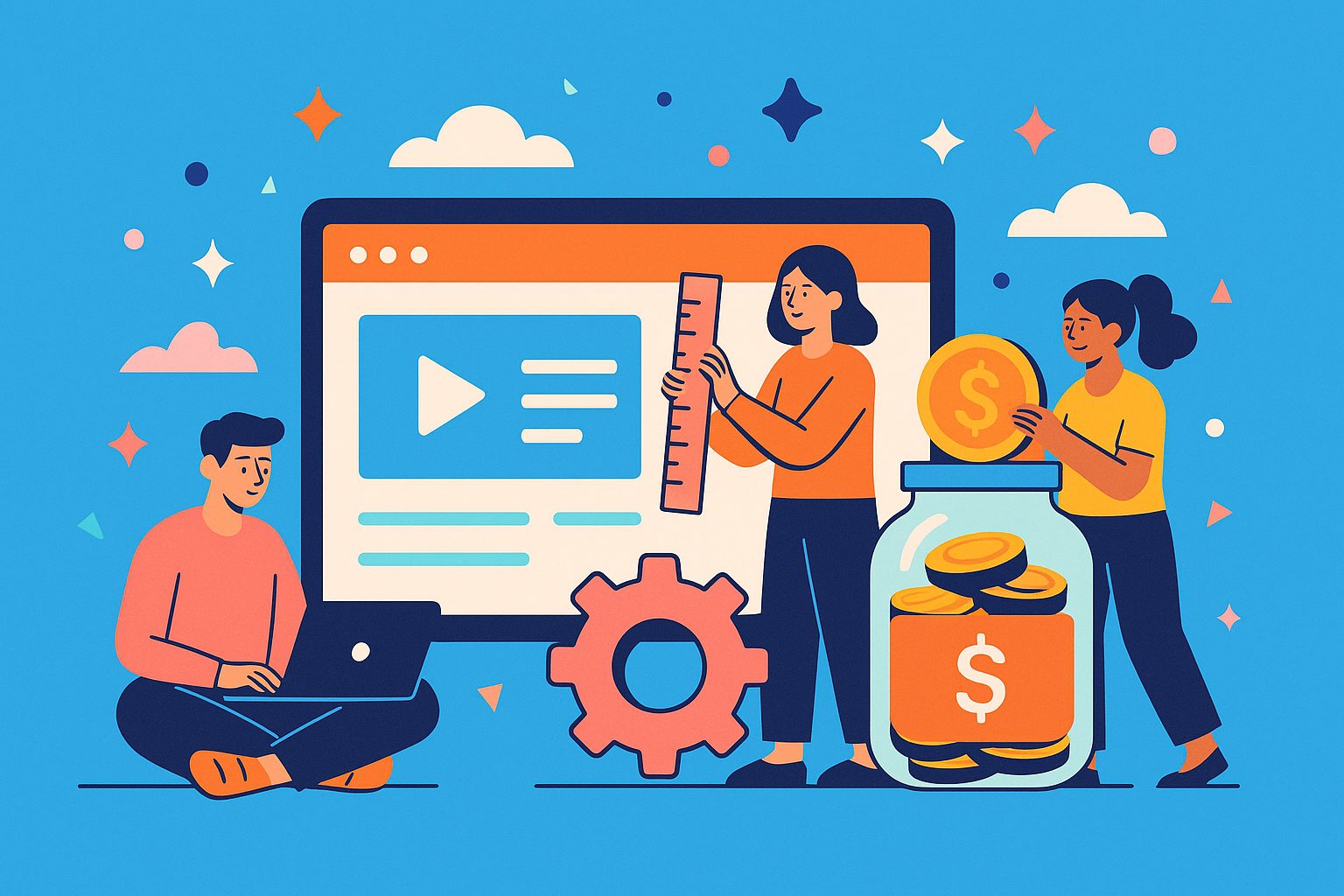The No-Code Revolution Is Here—And It’s Just Getting Started
In the past, launching a digital platform required months of development, hefty budgets, and a team of developers. But in 2025, that narrative has flipped entirely. Thanks to the explosive growth of no-code technology, creators from every industry are turning their ideas into functional, scalable platforms—without ever writing a single line of code. From entrepreneurs building custom marketplaces to nonprofit leaders creating donation portals, the no-code movement has unlocked a new era of creative independence. The tools are smarter, faster, and more flexible than ever, and they are built specifically to empower those with vision but not necessarily a technical background. If you’ve ever asked yourself whether it’s possible to launch your own platform without code, the answer is a resounding yes—and these tools prove it.
Why the No-Code Movement Is Changing Everything
No-code isn’t just a buzzword—it’s a structural shift in how software is built and who gets to build it. Traditional development required fluency in languages like JavaScript, Ruby on Rails, or Python. But now, visual development tools have taken center stage, turning abstract ideas into drag-and-drop simplicity. That means designers, marketers, educators, and small business owners can now bring their digital dreams to life in weeks instead of years. The benefits are enormous: lower costs, quicker testing, faster pivots, and complete creative control. With no-code, launching a platform isn’t a distant goal—it’s something you can do this month. And the ripple effects extend far beyond tech circles. It’s redefining entrepreneurship, reshaping education, and democratizing innovation in ways we’ve never seen before.
Webflow: Design-Driven Power Meets Professional Polish
When it comes to no-code tools that feel like true design playgrounds, Webflow stands at the top of the list. Perfect for creators who want full visual control while maintaining responsive, clean code under the hood, Webflow offers a powerful way to build platforms with both style and substance. Whether you’re launching a portfolio, a blog-based business, or a membership platform with advanced CMS capabilities, Webflow gives you the building blocks and the freedom to create pixel-perfect user experiences. With integrations for payments, logins, forms, animations, and even e-commerce, it’s no wonder so many startups use Webflow to go live faster without compromising on brand or user interface.
Bubble: The App Builder That Breaks All Limits
If your vision goes beyond static content and into dynamic functionality—think dashboards, logins, workflows, and user-generated content—Bubble is the no-code builder that rises to the challenge. In 2025, Bubble continues to lead the way for creators who want to build complex apps and interactive platforms without hiring engineers. It allows you to define user logic, set up real-time data interactions, and even integrate APIs with a simple visual editor. From crowdfunding portals to event management platforms, Bubble turns non-coders into product builders. Its flexibility is nearly endless, and while it may take some time to master, once you do, the possibilities are as big as your imagination.
Softr: Transforming Airtable into Full Platforms
Airtable has long been a favorite for organizing data, but Softr takes it to a new level by turning Airtable bases into live, functional websites. This makes Softr a perfect no-code solution for creators who want to build directories, course platforms, client portals, or membership sites. The beauty of Softr lies in its simplicity. You connect your Airtable, choose your templates, customize your blocks, and hit publish. Payment integrations, gated content, custom domains, and responsive design are all included. Softr lets creators go from spreadsheet to startup in record time, and it’s particularly great for those who love working visually while still needing access to relational data under the hood.
Glide: Build Mobile-First Apps from Google Sheets
In a mobile-first world, Glide gives creators the ability to launch slick, intuitive apps using nothing more than a Google Sheet. The platform turns spreadsheets into fully functional mobile and web apps, ideal for everything from internal tools to customer-facing experiences. If you’re trying to build something quickly—like a community directory, a reservation system, or a task manager—Glide delivers rapid development with zero code and high polish. It’s especially useful for educators, small businesses, and nonprofits who need something powerful but light, mobile-responsive, and easy to update. And because it’s built on a tool most people already use, the learning curve is remarkably gentle.
Carrd: The Landing Page King
Carrd may be simple, but that’s exactly its strength. This no-code builder is ideal for one-page websites, personal brands, product launches, and digital storefronts. With dozens of clean templates, responsive design, and integrations for payment and email, Carrd empowers creators to make bold first impressions without overcomplicating things. It’s perfect for validating ideas, collecting pre-launch signups, or linking multiple campaigns under one roof. And because it’s one of the most affordable no-code platforms on the market, it’s a no-brainer for lean startups and side hustlers looking to build quickly and beautifully.
Tilda: Storytelling Meets Conversion
When you want to launch a platform that feels immersive and expressive, Tilda shines. With its block-based editor and gorgeous typography, Tilda is the no-code builder of choice for visual creators, publishers, and agencies. It’s perfect for crowdfunding campaigns, landing pages, editorial sites, and event platforms where storytelling plays a central role. What makes Tilda different is its ability to blend compelling visuals with built-in lead capture, payment processing, and performance analytics. The result is a storytelling platform that drives conversion without requiring a developer or a single line of code. In 2025, Tilda is a go-to for campaigns that need to impress from the first scroll.
Notion + Super: From Workspace to Website
Notion has become a creator favorite for organizing projects, but in 2025, it’s also powering full websites—thanks to tools like Super. Super lets you turn your Notion pages into beautifully designed websites with custom branding, domains, and integrations. This combo is ideal for creators who already use Notion as their content engine and want to quickly spin up public platforms without learning a new tool. Whether it’s a community hub, a resource portal, or a publication, Super brings structure and style to your Notion content and makes it shareable with the world. It’s fast, minimalist, and surprisingly robust for those who already love working in Notion.
Why Creators Are Flocking to No-Code Tools
Beyond the obvious appeal of skipping developers, the deeper reason creators are embracing no-code platforms is speed. Time to market is shorter than ever, and creators need to test ideas, adapt quickly, and respond to feedback in real time. No-code tools allow for rapid iteration, meaning what used to take six months can now be built and launched in a matter of days or weeks. But it’s not just about launching fast—it’s also about launching smart. No-code platforms give creators access to real-time analytics, automation workflows, SEO settings, and deep customization options that used to require years of experience or large budgets. Now, you can launch, grow, and optimize with the same precision as a dev-heavy startup—without the baggage.
From Launch to Growth: Integrations and Automation
Launching a platform is just the first step. Scaling it requires data, automation, and integrated tools that streamline your workflow. Fortunately, most no-code platforms integrate seamlessly with services like Zapier, Make, Google Analytics, Mailchimp, Airtable, Stripe, and ConvertKit. This means your website or app isn’t just a digital front—it’s a living system connected to your marketing, analytics, and business processes. You can automate email sequences, manage user databases, send alerts, and even fulfill digital products—all without touching code. These integrations make it easy to focus on what really matters: your message, your mission, and your momentum.
Real Success Stories from Non-Coders
Every day, non-technical creators are launching platforms that change their industries and communities. A teacher launches a curriculum-sharing platform with Webflow. A nonprofit director builds a donation portal with Softr. A musician spins up a fan hub with Carrd. An indie publisher launches a serialized magazine with Tilda. These are not rare stories—they’re happening everywhere. The no-code revolution isn’t hypothetical. It’s happening now, and it’s turning side projects into startups and dreams into deliverables. With the right mindset and the right tools, creators are proving that you don’t need to be a developer to build something world-class. You just need a vision—and the courage to start.
The Platform You Imagine Is Closer Than You Think
There’s never been a better time to build. Whether you’re starting a niche marketplace, launching a course site, crowdfunding a creative idea, or organizing a community, the platform you’ve been imagining doesn’t have to stay an idea. With no-code tools, it can be built, tested, and shared faster than you thought possible. These platforms aren’t shortcuts—they’re springboards. They give you everything you need to move from concept to creation without detours, delays, or gatekeepers. In 2025, the question isn’t “Can I build this?” It’s “How soon can I go live?” And with the tools available today, the answer is: sooner than you think.




